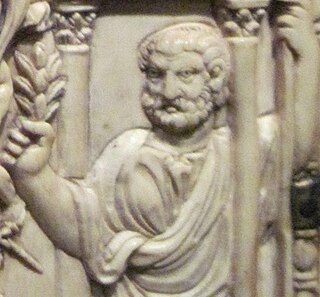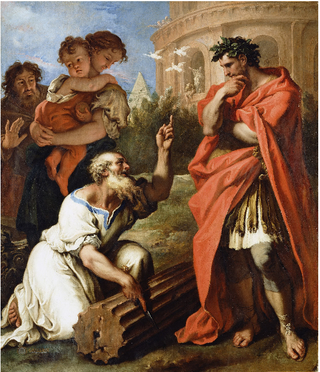Related Research Articles

Hostilian was briefly Roman emperor in 251. Hostilian was born to Decius and Herennia Etruscilla at an unknown date and elevated to caesar in 250 by Decius. After Decius and Herennius Etruscus, Hostilian's brother, were killed at the Battle of Abritus, an ambush by the Goths, Trebonianus Gallus was proclaimed emperor by the legions. Almost immediately, he elevated Hostilian to co-emperor and his own son, Volusianus, to caesar. Hostilian died soon after, either due to plague or being murdered by Trebonianus Gallus.
Lucius Appuleius Saturninus was a Roman populist and tribune. He is most notable for introducing a series of legislative reforms, alongside his associate Gaius Servilius Glaucia and with the consent of Gaius Marius, during the last years of the second century BC. Senatorial opposition to these laws eventually led to an internal crisis, the declaration of the senatus consultum ultimum, and the deaths of Saturninus, Glaucia, and their followers in 100 BC.
The gens Baebia was a plebeian family at ancient Rome. The first member of the gens who obtained the consulship was Gnaeus Baebius Tamphilus, in 182 BC. During the later Republic, the Baebii were frequently connected with the patrician family of the Aemilii.
Sextus Aurelius Victor was a historian and politician of the Roman Empire. Victor was the author of a short history of imperial Rome, entitled De Caesaribus and covering the period from Augustus to Constantius II. The work was published in 361. Under the emperor Julian (361-363), Victor served as governor of Pannonia Secunda; in 389 he became praefectus urbi, senior imperial official in Rome.

Quintus Aurelius Symmachus signo Eusebius was a Roman statesman, orator, and man of letters. He held the offices of governor of proconsular Africa in 373, urban prefect of Rome in 384 and 385, and consul in 391. Symmachus sought to preserve the traditional religions of Rome at a time when the aristocracy was converting to Christianity, and led an unsuccessful delegation of protest against Emperor Gratian's order to remove the Altar of Victory from the curia, the principal meeting place of the Roman Senate in the Forum Romanum. Two years later he made a famous appeal to Gratian's successor, Valentinian II, in a dispatch that was rebutted by Ambrose, the bishop of Milan. Symmachus's career was temporarily derailed when he supported the short-lived usurper Magnus Maximus, but he was rehabilitated and three years later appointed consul. After the death of Theodosius I, he became an ally of Stilicho, the guardian of emperor Honorius. In collaboration with Stilicho he was able to restore some of the legislative powers of the Senate. Much of his writing has survived: nine books of letters; a collection of Relationes or official dispatches; and fragments of various orations.

The gens Aurelia was a plebeian family at ancient Rome, which flourished from the third century BC to the latest period of the Empire. The first of the Aurelian gens to obtain the consulship was Gaius Aurelius Cotta in 252 BC. From then to the end of the Republic, the Aurelii supplied many distinguished statesmen, before entering a period of relative obscurity under the early emperors. In the latter part of the first century, a family of the Aurelii rose to prominence, obtaining patrician status, and eventually the throne itself. A series of emperors belonged to this family, through birth or adoption, including Marcus Aurelius and the members of the Severan dynasty.

The Forma Urbis Romae or Severan Marble Plan is a massive marble map of ancient Rome, created under the emperor Septimius Severus between 203 and 211 CE. Matteo Cadario gives specific years of 205–208, noting that the map was based on property records.

De Viris Illustribus, meaning "concerning illustrious men", represents a genre of literature which evolved during the Italian Renaissance in imitation of the exemplary literature of Ancient Rome. It inspired the widespread commissioning of groups of matching portraits of famous men from history to serve as moral role models.

In Ancient Roman mythology, Attus Navius was a famous augur during the reign of Tarquinius Priscus.
Faustus Cornelius Sulla was a politician of the Roman Republic. He was the son of the dictator Lucius Cornelius Sulla. He spent most of his career in the shadow of his father-in-law Pompey, whom he followed during the Civil War against Julius Caesar. He was killed soon after the battle of Thapsus in 46 BC.
Eustace I Granier, also known as Eustace Grenier or Eustace Garnier, called in Latin Eustachius Granarius in the charters, was a Flemish crusader who took part in the First Crusade. He became lord of Caesarea in 1101 and lord of Sidon in 1110. On 18 April 1123, he was elected constable and bailiff of Jerusalem during the captivity of Baldwin II of Jerusalem. Shortly before his death, he defeated a Fatimid army at the Battle of Yibneh near Ibelin.
Eustace Grenier is quoted in a text in verse written during his life in honour of the knights of the diocese of Thérouanne who accompanied Baldwin of Boulogne to the Holy Land.
Contemporary authors and historians identify Eustace Grenier as a nobleman from the diocese of Thérouanne in the County of Saint-Pol. Alan V. Murray, historian of the Crusades, writes: "However, his origins can be established with a high degree of certainty. The Versus de viris illustribus diocesis Tarvanensis qui in sacra fuere expeditione identifies him as a Fleming from the diocese of Therouanne".

Mirabilia Urbis Romae is a grouping of hundreds of manuscripts, incunabula, and books in Latin and modern European languages that describe notable built works and historic monuments in the city of Rome. Most of these texts were intended as guidebooks to the city for pilgrims and visitors. Before the fourteenth century, however, the core text seems instead to have served as a census of the built patrimony of the city, the decus Urbis. This inheritance represented the strength of Rome and the power of the institutions that controlled it.
Marcus Livius Drusus was a Roman politician and reformer. He is most famous for his legislative programme during his term as tribune of the plebs in 91 BC. During his year in office, Drusus proposed wide-ranging legislative reforms, including offering citizenship to Rome's Italian allies.

Andreas Schott was an academic, linguist, translator, editor and a Jesuit priest from Antwerp in the Habsburg Netherlands. He was mainly known for his editions of Latin and Greek classical literature.

Ceterum (autem) censeo Carthaginem esse delendam, often abbreviated to Carthago delenda est or delenda est Carthago, is a Latin oratorical phrase pronounced by Cato the Elder, a politician of the Roman Republic. The phrase originates from debates held in the Roman Senate prior to the Third Punic War between Rome and Carthage. Cato is said to have used the phrase as the conclusion to all his speeches, to push for the war.

The title vir illustris is used as a formal indication of standing in late antiquity to describe the highest ranks within the senates of Rome and Constantinople. All senators had the title vir clarissimus ; but from the mid fourth century onwards, vir illustris and vir spectabilis were used to distinguish holders of high office.
The Enmannsche Kaisergeschichte is a modern term for a hypothetical Latin historical work, written in the 4th century, but now lost.
The gens Decia was a plebeian family of high antiquity, which became illustrious in Roman history by the example of its members sacrificing themselves for the preservation of their country. The first of the family known to history was Marcus Decius, chosen as a representative of the plebeians during the secession of 495 BC.
The Lexicon Topographicum Urbis Romae (1993–2000) is a six-volume, multilingual reference work considered to be the major, modern work covering the topography of ancient Rome. The editor is Eva Margareta Steinby, and the publisher is Edizioni Quasar of Rome. It is considered the successor to Platner and Ashby's A Topographical Dictionary of Ancient Rome.
The lex Appuleia agraria was a Roman agrarian law introduced by the plebeian tribune Lucius Appuleius Saturninus during his second tribunate in 100 BC. The law concerned the distribution of land to poor Romans and to Gaius Marius' veterans. According to Appian, this was to be provided from land that had been seized by the Cimbri in Transalpine Gaul. A separate but related law also established colonies Sicily, Achaea, Macedonia, and possibly Africa.
References
- ↑ Victor, Ps. Aurelius (2016). Fugmann, Joachim (ed.). De viris illustribus urbis Romae. Darmstadt: WBG. pp. 20–25, 31. ISBN 978-3-534-23852-1.
- ↑ Victor, Ps. Aurelius (2016). Martin, Paul Marius (ed.). Les hommes illustres de la ville de Rome. Paris: Les Belles Lettres. pp. XLIX–LV.
- ↑ Victor, Ps. Aurelius (2016). Fugmann, Joachim (ed.). De viris illustribus urbis Romae. Darmstadt: WBG. pp. 9–14. ISBN 978-3-534-23852-1.
- ↑ Victor, Ps. Aurelius (2016). De viris illustribus urbis Romae. Darmstadt: WBG. pp. 17–19. ISBN 978-3-534-23852-1.
- ↑ Bendz, G. (1939). Hanell, K. (ed.). Eine lateinische Exemplabiographie. Bemerkungen über den anonymen Liber de viris illustribus urbis Romae. Lund. pp. 55–66.
{{cite book}}: CS1 maint: location missing publisher (link) - ↑ Victor, Ps. Aurelius (2016). De viris illustribus urbis Romae. Darmstadt: WBG. pp. 20–25. ISBN 978-3-534-23852-1.
- ↑ Victor, Ps. Aurelius. Martin, Paul Marius (ed.). Les hommes illustres de la ville de Rome. Paris: Les Belles Lettres. pp. XLIX–LVI.
- ↑ Victor, Ps. Aurelius (2016). Fugmann, Joachim (ed.). De viris illustribus urbis Romae. Darmstadt: WBG. pp. 27–33. ISBN 978-3-534-23852-1.
- ↑ Schmidt, Peter L. (1978). "Sex. Aurelius Victor". RE Suppl. (XV): 1583–1676.
- ↑ Schmidt, Peter L. (1978). "Sex. Aurelius Victor". RE Suppl. (XV): 1643.
- ↑ Schmidt, Peter L. (1978). "Sex. Aurelius Victor". RE Suppl. (XV): 1637–1640.
- ↑ Sage, M. M. (1979). "The Elogia of the Augustan Forum and the De viris illustribus". Historia (28): 192–210.
- ↑ Victor, Ps. Aurelius (2016). Fugmann, Joachim (ed.). De viris illustribus urbis Romae. Darmstadt. pp. 31–33. ISBN 978-3-534-23852-1.
{{cite book}}: CS1 maint: location missing publisher (link) - ↑ Schmidt, Peter L. (1978). "Sex. Aurelius Victor". RE Suppl. (XV): 1644–1655.
- ↑ Fugmann, Joachim (2006). "Pompeius oder Kleopatra. Zum Schluss der Schrift De viris illustribus urbis Romae". Philologus (150): 136–148.
- ↑ Schmidt, Peter L. (1978). "Sex. Aurelius Victor". RE Suppl. (XV): 1583–1602.
- ↑ Victor, Ps. Aurelius (2016). Fugmann, Joachim (ed.). De viris illustribus urbis Romae. Darmstadt: WBG. pp. 9–16. ISBN 978-3-534-23852-1.
- ↑ Victor, Ps. Aurelius (2016). Martin, Paul Marius (ed.). Les hommes illustres de la ville de Rome. Paris: Les Belles Lettres. pp. VII–XXXIV, LXI–LXXV. ISBN 978-2-251-01470-8.